A dovecote is a great aesthetic addition to any garden with the added bonus of attracting pigeons.
To attract pigeons to your dovecote, you need:
- A dovecote that is practical as well as attractive
- Safe location away from predators
- A food source
- Water
- Trees or shrubs pigeons like to perch in
1. A Good Dovecote Design Helps Attract Pigeons
The first step in attracting pigeons to your garden is providing a dovecote that they want to visit as well as consider making their home.
Pigeons will land and perch on any stable and flat surface so your dovecote has to have wide ledges or easily gripped perches.
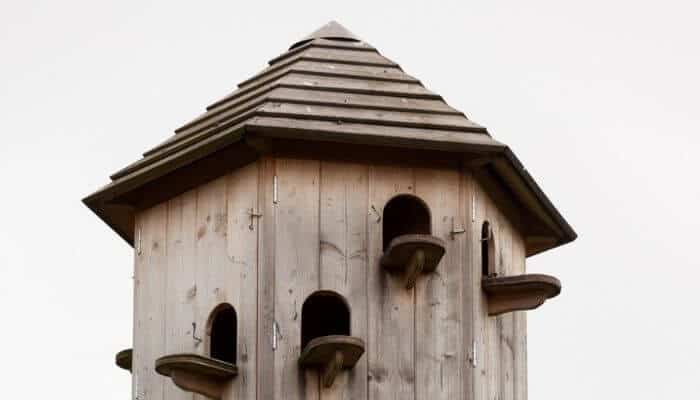
Holes should be big enough for pigeons to enter and exit easily but not too big to allow access to larger birds such as crows.
It is best if the dovecote is situated well off the ground and well away from any other structure that pigeon predators can use for hunting purposes.
It is recommended the dovecote is at least 2 meters off the ground (but should be less than 3 meters tall to avoid running foul of planning regulations in the UK).
You can choose between a free-standing, wall-fixed or ground-fixed dovecote – the type shouldn’t have any impact on whether it attracts pigeons as a single factor.
Other factors are more significant.
2. Food Will Attract Pigeon’s To Your Dovecote
Most birds of any species who visit your outdoor space come for the same reason – food.
It soon gets around the bird community if there are rich pickings to be had in your garden.
When it comes to what pigeons eat, they have quite simple tastes.
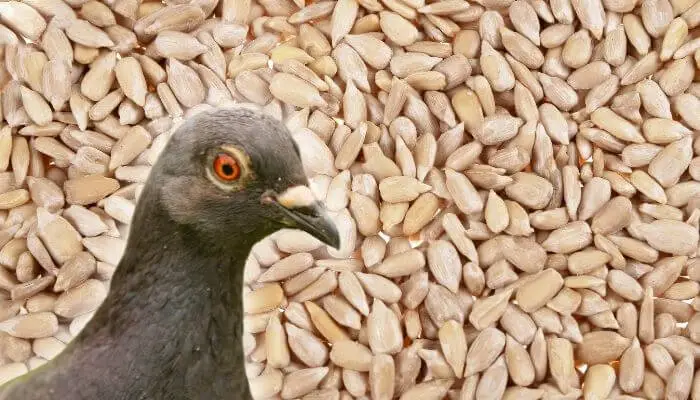
Feral pigeons are opportunistic feeders known to eat pretty much anything but don’t see your dovecote as a birdy garbage can.
Wood pigeons are granivorous birds who will mainly eat
- Wheat
- Barley
- Millet
- Sunflower Seeds
- Dried peas
- Cracked Corn
- Sorghum
Fit your dovecote with suitable pigeon feeders and fill them with a seed and grain mix you can source from a local pet store or online.
Once you build up a population or a flock of regular visitors, you might consider enticing or rewarding them with a few treats like bananas, popcorn and chopped-up vegetables.
3. Provide A Source Of Water
You stand a much better chance of your dovecote being a continual attraction if you also provide a source of water alongside your food.
If you don’t have water, wily pigeons will come and eat your food and then leave to find water for drinking and bathing.
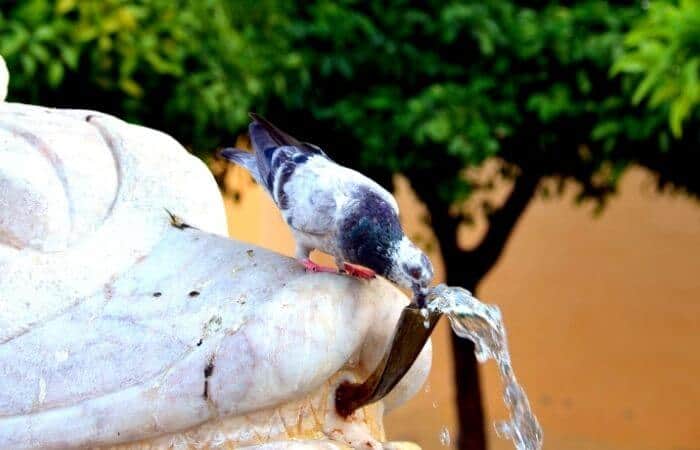
Water should be easily accessible.
If you have a feeder in the dovecote, add a suitable water container too.
You might also consider a birdbath conveniently located close to the dovecote.
Don’t let the water sources run dry.
The drinking water should be fresh and clean while it’s okay to allow rainwater to fill up the birdbath with you topping it up as necessary.
4. Make the Environment Attractive
Sometimes a pretty, well-stocked dovecote isn’t enough.
You need to consider the general setting for your dovecote.
Although you are providing food in the dovecote, consider a bird table too.
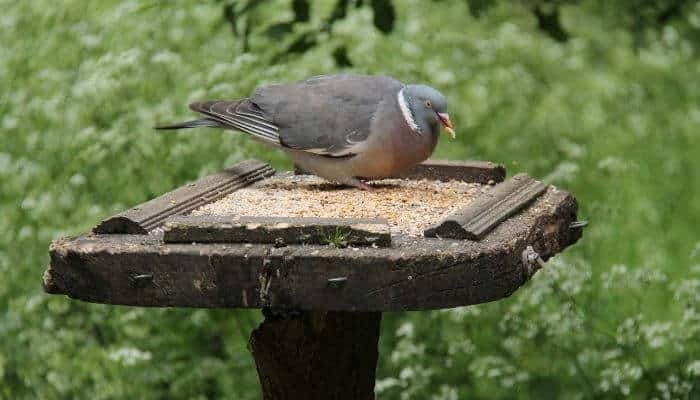
Hanging bird feeders are great for small birds like sparrows, tits, blackbirds and starlings, but pigeons can’t perch hang to eat as their grips are not good enough.
As ground-feeding birds, they need to land and stand.
You can also make the immediate environment attractive by having seed or berry-bearing plants around as these will provide additional food alongside what you provide.
You might also think about scattering some food on the ground around the dovecote to attract pigeons in the first place.
Their curiosity will soon cause them to investigate the dovecote.
Why Have a Dovecote?
If you are a pigeon lover and like having these wonderful creatures around on a permanent basis, then a dovecote is an ideal solution.
With a dovecote, you get the benefit of seeing multitudes coming and going with total freedom.
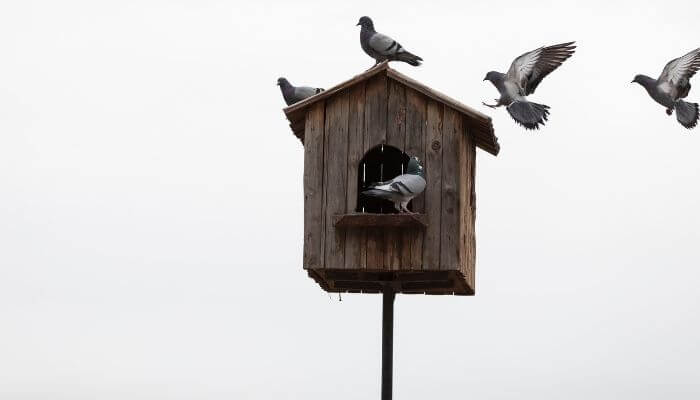
Pigeons are fascinating and intelligent birds and contrary to their poor (undeserved) reputation, pigeons do good things for the environment.
Pigeons are full of character and providing them with a place of safety where they can roost and nest is a great way to enjoy them.
It doesn’t matter if you live in a rural or urban setting, you first have to attract them to your site whether you build a dovecote or purchase one that is ready assembled.
Here are some tips that you may find useful.
Will Pigeons Nest in Your Dovecote?
This is an interesting question because this is one of the aspirations of many who choose to have a dovecote.
As they prefer an open cup type of nest, wood pigeons make their nests in many types of sheltered places but not totally enclosed spaces like a dovecote.
If you want to encourage nesting pairs to your garden to use your dovecote for feeding and socialising, leave nesting materials around for them to find.
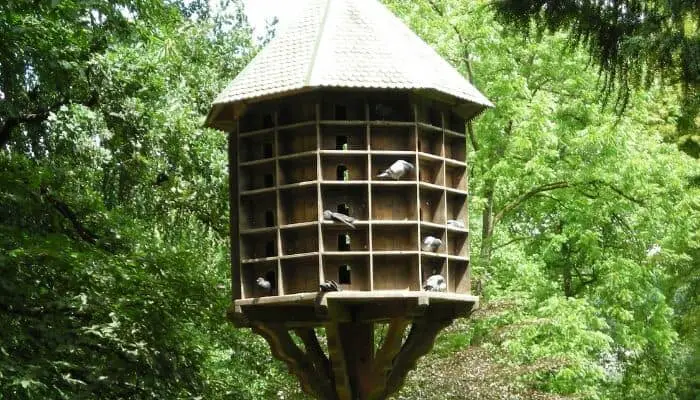
But it isn’t all negative.
Historically, pigeons were kept in really large dovecotes which can still be evidenced in the ancient pigeon towers of the Middle East.
Modern anecdotal and scientific evidence, however, is that pigeons (and indeed doves) are unlikely to independently make a permanent home in your garden dovecote.
You can engineer the process by choosing a dovecote over a loft set up for your flock.
The dovecote will need nesting boxes and you will need to secure the pigeons in the dovecote to condition them into accepting it as their home.
You’ll find plenty of advice on pigeon-keeping for beginners that will encourage you through the process.
Go & Attract Pigeons To Your New Dovecote
You can attract pigeons to your dovecote quite easily if you provide a regular source of food and water.
If you want to use your dovecote to house and raise pigeons, you’ll need to be more hands-on and work at it, but probably with just a little more effort than using a loft.
